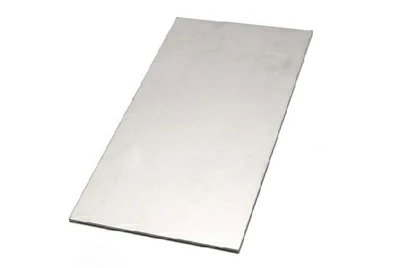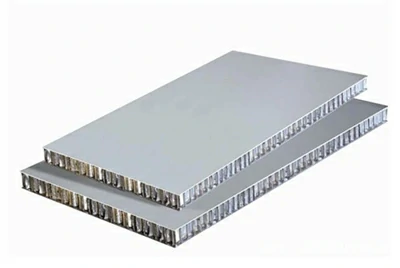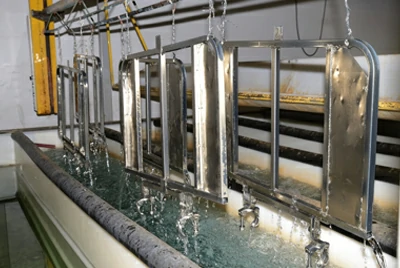Titanium Clad Aluminum
Updated : Oct. 23, 2025Titanium clad aluminum combines the corrosion resistance of titanium with the light weight and high thermal conductivity of aluminum.
It can resist seawater, acids, alkalis, and electrolytes, while reducing the overall weight by more than 30%, improving heat exchange efficiency, and lowering energy consumption.
Compared with solid titanium, it is more cost-effective. Compared with steel, it is lighter. It is an ideal material that balances service life, efficiency, and budget.
Titanium clad aluminum specifications
- Titanium layer (surface layer): Commonly Gr1 / Gr2, optional Gr5 / Gr7 / Gr12 / Gr16 for special corrosive media
- Aluminum layer (base material): Commonly 1060 / 1070, optional 6061 for higher structural strength
- Intermediate layer (optional): Pure aluminum layer to prevent intermetallic compounds, improve welding and forming
- Manufacturing process: Explosion bonding and rolling
- Surface treatment: Rolled surface, polishing, sandblasting
- Edge treatment: Edge-sealing weld, open-cut edge
- Titanium cladding thickness ≤ 2 mm
- Aluminum base thickness ≤ 10 mm
- Maximum width ≤ 1200 mm
Complies with ASTM B898, with additional ASME, JIS, or other standards available upon project requirements.
Each batch undergoes 100% ultrasonic (UT) testing, with optional shear and bend interface strength tests on request. Supplied with EN 10204 3.1 certificate.
Titanium clad aluminum popular products
Titanium clad aluminum plate
Titanium clad aluminum plate is produced by explosion bonding and hot rolling, creating a strong bond between titanium and the aluminum base. It offers excellent durability.
Contact us now
It combines titanium's corrosion resistance with aluminum's light weight and high thermal conductivity. It resists seawater and acid-alkali corrosion, reduces overall weight by over 30%, and improves heat exchange efficiency.
Compared with solid titanium, it saves material, is easier to process and transport, and significantly lowers equipment costs. It is the ideal choice for balancing service life and budget.
- Thickness range: 1.0 mm – 12.0 mm
- Width: Standard ≤ 1200 mm (up to 3 m maximum)
- Length: Up to 12 m (customized on request)
- Supply form: Plate, coil, cut-to-size
- Surface treatment: As-rolled / polished / sandblasted
To improve welding and forming performance, an industrial pure aluminum intermediate layer is often used. It prevents brittle intermetallic compounds and greatly enhances workability.
Through hot rolling, the plates achieve more uniform structure and higher dimensional accuracy. They meet industry needs for strength, light weight, and corrosion resistance.
We not only supply titanium clad aluminum plates but also provide excellent processing performance. Embossing, punching, and complex forming can be achieved with ease.
The material can be made into tube sheets, honeycomb panels, or corrugated plates, offering one-stop solutions for diverse applications.
Titanium clad aluminum tube sheet
Used in heat exchangers and seawater desalination. The titanium layer resists corrosion, while the aluminum base keeps it light, balancing life and cost.
Contact us now
- Base material: High-strength aluminum alloy, providing stiffness and support
- Cladding: Titanium layer (commonly Gr1/Gr2), directly exposed to seawater, acids, alkalis, or chloride media
- Titanium layer: 1–3 mm
- Aluminum base: 10–50 mm, with optional intermediate layer and nozzle edge sealing
Titanium clad aluminum tube sheets use edge sealing to prevent leakage, ensuring long-term corrosion resistance.
Supplied with EN 10204 3.1 and UT inspection reports, fully meeting engineering compliance requirements.
Titanium clad aluminum honeycomb panel
Lightweight and strong, with a titanium surface that offers weather resistance for over 100 years. Ideal for building façades, roofing, and lightweight structures.
Contact us now
- Core: Aluminum honeycomb core (10–20 mm)
- Back layer: Titanium clad aluminum plate (0.8–1.5 mm)
- Total thickness: 20–30 mm, adjustable to project requirements
Titanium aluminum honeycomb panels combine century-long durability, light weight, high strength, and metallic texture, meeting engineering needs for both appearance and performance.
Aluminum titanium transition joint
The aluminum-titanium transition joint uses metallurgical bonding to join titanium and aluminum. It supports reliable welding, resists corrosion, and ensures stable conductivity.
Contact us now
- Customizable size, thickness, and lap length according to drawings
- Supports edge-sealing, beveling, and drilling
- Supplied with EN 10204 3.1 certificate and UT inspection report, with upgrade to 3.2 or third-party witnessing if required
Aluminum-titanium transition joints are widely used in heat exchanger tube sheets and tube ends, chemical equipment connections, busbars, and equipment transitions. They are the ideal solution for joining dissimilar materials.
Titanium clad aluminum rod / bar
The outer titanium sheath provides corrosion resistance, while the aluminum core ensures conductivity and light weight.
Contact us now
- Length: Custom cut, up to 3 m
- Titanium sheath: About 0.8 mm (Ti Grade 2 / 3.7025)
- Common diameters (Ø): 19 mm, 20 mm
- other sizes can be machined to drawings
Titanium clad rods have a titanium outer layer for corrosion protection and an aluminum core for light weight and conductivity. They can be cut to length and support drilling, tapping, welding, and sealed ends, making them durable and easy to assemble.
They are widely used in electroplating and electrolysis fixture shafts, conductive beams, anode/cathode supports, surface treatment jigs, and lightweight busbar upgrades.
Aluminum titanium anode
The aluminum-titanium anode uses a titanium layer to resist strong corrosion from chlorides, acids, and alkalis. The aluminum core provides light weight and good conductivity.
Compared with traditional pure titanium or coated anodes, it maintains stable current output, reduces electrolyte contamination, and lowers energy consumption.
Products can be cut-to-size according to tank dimensions, with edge-sealing weld or open-cut end options to ensure safe and reliable operation.
Applications of titanium clad aluminum
Chemical / chlor-alkali / hydrometallurgy
The titanium face resists chlorides, acids, and alkalis. The aluminum backing is lightweight and conductive, giving higher efficiency, lighter equipment, and longer service life.
Contact us now
- Reactor and storage tank lining
- Plate and shell-and-tube heat exchanger plates
- Tube sheets
Seawater desalination / offshore
Resistant to seawater, reduces weight for easier lifting, and enables faster installation. Edge-sealing weld is recommended for long-term immersion.
Contact us now
- Desalination plate assemblies
- Condenser components
- Platform panels and partitions
Heat exchanger OEM (thermal equipment)
Aluminum's high thermal conductivity reduces approach temperature. Titanium resists pitting and crevice corrosion. NDT-cleared bonds ensure long-term operation.
Contact us now
- Plates
- Tube sheets
- Aluminum-titanium transition joints
- Compact heat exchanger modules
Electrochemistry / electroplating (fixtures and conductive parts)
The Ti sheath with Al core combines corrosion resistance and conductivity. Edge-sealing at the ends prevents leakage, while cut-to-length supply allows immediate installation.
Contact us now
Advantages of titanium clad aluminum
- Titanium layer resists seawater, acids, alkalis, and electrolytes, extending service life and reducing downtime.
- Overall weight reduced by more than 30%; lower cost than solid titanium and easier transport and installation than steel.
- Aluminum base offers fast thermal conductivity, improving heat exchange efficiency and reducing energy consumption.
- Maintains strength and stability in medium- and high-temperature environments, suitable for chemical and energy equipment.
- Explosion bonding and hot rolling deliver high bonding strength.
- Overall cost of material, processing, transport, installation, and maintenance is lower than all-titanium solutions.
- Supplied with EN 10204 3.1/3.2 certificates and UT testing to ensure smooth acceptance.
Properties of titanium clad aluminum
Our Ti/Al explosion-bonded plates are strong and tough, lightweight, corrosion-resistant, easy to process, and have a high inspection pass rate. They help customers improve efficiency, extend service life, and reduce costs.
- Tensile strength: 448–466 MPa, yield strength: 335–357 MPa
- Elastic modulus: about 8.2×10⁴ MPa
- Elongation: 31–39%, bending angle over 180°, suitable for bending, rolling, and drilling
- Explosion-welded metallurgical bond, bonding strength greater than 370 MPa
- Reduces weight by over 30% compared with solid titanium, while stronger than ordinary aluminum, lowering total cost in transport, installation, and use
Table 3.2.15.1 Mechanical properties of explosion-bonded Ti/Al composite plates
| No. | σb / MPa | σ0.2 / MPa | δ / % | E / MPa | α / (°) |
|---|---|---|---|---|---|
| 1 | 448 | 335 | 31.2 | 82615 | >180 |
| 2 | 453 | 349 | 32.1 | 81830 | >180 |
| 3 | 466 | 357 | 39.0 | 83500 | >180 |
| LY12CZ | >426 | >279 | 10 | - | - |
| Suzhou plate | 457–465 | 391–400 | 21.2–26.9 | 81730 | - |
Table 3.2.15.2 Relationship between waveform parameters of Al–Ti–Al composite plates and bonding strength
| vp (m/s) | Λ (mm) AM6–AD1 | Λ (mm) AD1–OT4 | λ (mm) AM6–AD1 | λ (mm) AD1–OT4 | Bond strength / MPa (AM6) | Bond strength / MPa (AD1) | Bond strength / MPa (OT4) |
|---|---|---|---|---|---|---|---|
| 500 | 0.05 | 0.64 | 0.79 | 0.10 | 372 | - | 3107 |
| 540 | 0.09 | 0.67 | 0.97 | 0.13 | 390 | - | 3322 |
| 570 | 0.17 | 0.92 | 1.36 | 0.23 | 392 | - | 3469 |
Manufacturing process of titanium clad aluminum
Explosion welding
Explosive shock waves drive titanium and aluminum into high-speed collision, forming a metallurgical bond with a wavy interface.
The bond strength is high and free from delamination. Suitable for large-area and thick plates, widely used in chemical, desalination, and heat exchanger industries.
Rolling composite
Titanium and aluminum sheets are stacked and hot rolled under high temperature, allowing atoms to diffuse and bond.
The process is efficient and cost-effective, suitable for thin plates and precision parts such as in medical and electronics industries.
Diffusion welding / foil metallurgy
Titanium and aluminum atoms directly diffuse and bond under high temperature and pressure, creating a clean and impurity-free interface. Ideal for small-size, high-precision special components.
We adopt advanced processes such as explosion welding and rolling composite. They tightly combine titanium's corrosion resistance with aluminum's light weight and thermal conductivity.
This allows both thick and thin plates, ensuring strong, reliable, and cost-effective products for chemical, marine, heat exchange, and electronics industries.
Processing & fabrication
- Cutting and sizing: Plates can be cut, leveled, and trimmed to width and length as per drawings, including circular and irregular profiles.
- Forming: Shearing, bending, rolling, hot forming, and drawing are available. Minimum bend radius and forming direction recommendations are provided, suitable for shells and heads.
- Edge sealing weld: Recommended for seawater, electrolysis, or long-term humid environments. Effectively prevents medium penetration into the composite interface.
- Machining: Supports drilling, tapping, slotting, chamfering, beveling, and marking. The aluminum side allows conventional machining while protecting the titanium surface.
- Surface treatment: Options include as-rolled, polished, or sandblasted, meeting different cleanliness or coating requirements.
- Dissimilar material connection: Custom titanium-aluminum transition joints are available for reliable welding on either titanium or aluminum side. Steel connection solutions can also be provided if required.
Our services
- EN 10204 3.1 inspection documents supplied with each shipment, with 3.2 or third-party witnessing available.
- Every batch undergoes 100% ultrasonic testing, with shear and bend test summaries provided to ensure full traceability.
- Corrosion-resistance quick reference tables, edge-sealing and assembly guidance, and forming advice (minimum bend radius, thermal cycle notes) are available.
- Datasheets, sample inspection reports, and quick guides for sealing and welding are provided to shorten design and inquiry cycles.
- Retained samples and complete records for each batch, with video pre-inspection or on-site inspection supported. Additional NDT re-inspection available before shipment.
- International standard wooden cases, moisture-proof and corrosion-resistant, with edge protection and clear Ti/Al side marking. Complete customs clearance documents included.
- Strict control of process parameters, with recommendations for intermediate layer design and guidance for complex forming. Feasibility letters can be issued if needed.
- Technical and business communication available in English, Japanese, and Spanish. Service covers the USA, Europe, Japan, Mexico, and other markets.


Related products – clad metals solutions
Explore more clad metal solutions—besides copper-aluminum composite, we also supply titanium clad copper, copper clad steel, aluminum clad steel and other tailored combinations to match your industry needs.

Copper Clad Steel

Copper Clad Aluminum

Aluminum Clad Steel

Titanium Clad Copper

Titanium Clad Nickel

Titanium Clad Steel
Click to view our clad product page, featuring all titanium clad materials.
FAQ – Frequently asked questions
Is edge-sealing weld always necessary?
If the edges are exposed to seawater or electrolytes, sealing is recommended to prevent penetration. For dry side or fully enclosed environments, open cutting is acceptable.
Can titanium clad aluminum plates be bent or rolled?
Yes, but forming guidelines must be followed. We provide bend radius recommendations for different thicknesses and layers.
What are the advantages compared with solid titanium or titanium-clad steel?
Compared with solid titanium, it is lower in cost and lighter in weight. Compared with titanium-clad steel, it is better suited for applications requiring thermal conductivity and light weight.
Can small batch samples be supplied?
Yes. We provide sample blocks or cut segments and can offer a budgetary quote the same day.
Is it used in electronic products?
Yes. For example, Apple's published patents mention Ti/Al composite substrates with anodized coatings for device housings, improving scratch and corrosion resistance.
Is aluminum-titanium cookware safe?
Yes, it is safe. Aluminum-titanium composite cookware usually applies a titanium layer on the food-contact surface. Titanium offers excellent corrosion resistance and biocompatibility, and it does not react with food.
The aluminum layer mainly provides heat conduction and light weight, without direct contact with food. Compared with pure aluminum pots, it is more corrosion-resistant, and compared with full titanium pots, it is lighter and easier to use.




